The positive airway pressure therapy machine can also be called a PAP machine, which can be divided into three types based on the variety of positive airway pressure therapy:
- CPAP machine(BMC E-20C,BMC G2S C20,BMC G3 C20)
- Auto CPAP machine (also named APAP machine)
- BiPAP machine (also named BPAP)
CPAP machine and APAP machine deliver air at a single pressure setting between the inhale and exhale; while the BiPAP machine has two pressure settings for inhaling and exhaling.
The CPAP machine is suitable for patients with OSA (obstructive sleep apnea) and snoring.
The BiPAP machine is used for patients with COPD (chronic obstructive pulmonary disease) and CSA (Central sleep apnea).
Learn more about PAP therapy:3 Types of PAP Therapy
CPAP machine
CPAP, also known as a continuous positive airway machine, is a machine that delivers a single air pressure when pressure relief is turned off. As pressure relief is turned on, the CPAP machine automatically gives a low air pressure during exhalation, allowing the patient to breathe out more easily. It works whether you have a sleep apnea condition anytime or breathe normally.
CPAP was first invented, so people usually call PAP machines generically CPAP machines.
APAP machine
The APAP has been improved based on CPAP. The pressure of the APAP machine can be adjusted according to the patient's condition and it has a built-in pressure feedback device. The machine will deliver low air pressure when patients are breathing normally, and higher air pressure when patients have sleep apnea, shallow breathing, or snoring.
Patients with sleep apnea are not always in the condition of apnea, shallow breathing, respiratory effort-related arousals, or snoring all night, so people prefer an APAP machine rather than the CPAP machine. The average air pressure of APAP is 40% lower than that of CPAP. This data explains why patients feel more comfortable using an APAP machine even if they use it for the first time. In general, the APAP machine is very suitable for patients with long-term use, and it can help control the illness caused by sleep apnea.
After a long period, when your airway or physical condition has changed, don't worry, this machine will be adjusted according to your condition.
BiPAP machine
BiPAP can be considered to be the ultimate solution for patients who require higher air pressure. It is specifically aimed at patients with COPD (chronic obstructive pulmonary disease) and ALS (Amyotrophic Lateral Sclerosis). The BiPAP machine is also more expensive than the APAP machine, so it is more suitable for people with enough budget or overweight patients (generally >125kg). The CPAP machine and BiPAP machine can both be used to treat sleep apnea.
Currently, some BiPAP machines can not only automatically adjust respiratory cycles in Spontaneous Mode but also set the respiratory cycle in Timed Mode.
Some machines also have Natural Mode. When they detect that the user is not breathing naturally, they can automatically intervene to make sure your breath several times per minute. This is called the backup rate.
At present, the Bipap machine can be used to treat different diseases such as COPD (chronic obstructive pulmonary disease), chronic obstructive pulmonary disease, CSA (central sleep apnea), emphysema, motor neuron, mild pulmonary alveoli, and Limbari syndrome.

APAP Machine vs CPAP Machine
The CPAP machine is more suitable for patients with mild diseases. Before using the CPAP machine, you should do the titration study, and then you will get a low air pressure for comfort. Pressure CPAP machines are less expensive and great for more tolerant people.
The APAP machine is very popular now because the titration study can be done at home instead of going to the hospital. Your doctor can monitor the data remotely from the APAP machine.
The APAP machine can also be adjusted to CPAP mode, which is a single pressure setting to deliver air pressure.
In addition, the APAP machine is suitable for a wider range of people. The automatic pressure adjustment of the APAP allows for a balance between comfort and effectiveness. In the past, for patients with mild symptoms, doctors usually let them use the CPAP machine first, and then change to the APAP machine when intolerance occurs, which can be a long and tedious process.
BiPAP Machine vs CPAP Machine
The BiPAP machine has two air pressure settings: IPAP (inhalation positive airway pressure) and EPAP (exhalation positive airway pressure) Both pressure settings can be adjusted, whereas the CPAP can only adjust the inspiratory pressure.
Lower expiratory pressure allows for a more comfortable exhalation. For example, if your blood oxygen is very low, your doctor may recommend that you increase your inspiratory pressure to allow more air into your lungs. However, it can be difficult to exhale at higher air pressure. A BiPAP machine can help lower the pressure as you exhale, making you more comfortable breathing.
Although CPAP machines don't have two pressure settings, many CPAP machines including APAP machines and CPAP machines on the market have a so-called Pressure Relief function. It can help reduce pressure when the user exhales.
CPAP machines are mainly used for the treatment of obstructive sleep apnea (OSA), while BiPAP machines are used to treat central sleep apnea (CSA), complex sleep apnea, or chronic obstructive pulmonary disease (COPD).




